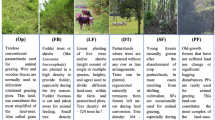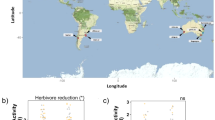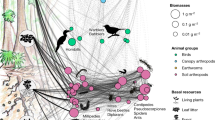Abstract
Wild herbivore populations are declining in many African savannas, which is related to replacement by livestock (mainly cattle) and the loss of megaherbivores. Although some livestock management practices may be compatible with the conservation of native savanna biodiversity, the sustainability of these integrated wild herbivore/livestock management practices is unknown. For instance, how will these herbivore mixes influence key processes for the long-term functioning of savanna ecosystems, such as soil carbon, nitrogen and phosphorus pools and cycling? The Kenya Long-term Exclosure Experiment studies the ecosystem consequences of manipulating the presence and absence of wild herbivores and cattle at moderate densities in a ‘black cotton’ savanna. Here we show that after 20 years, cattle presence decreased total soil carbon and nitrogen pools, while the presence of megaherbivores (mainly elephants) increased these pools and even reversed the negative effects of cattle. Our results suggest that a mix of cattle at moderate densities and wild herbivores can be sustainable, provided that the assemblage of wild herbivores includes the largest species.
This is a preview of subscription content, access via your institution
Access options
Access Nature and 54 other Nature Portfolio journals
Get Nature+, our best-value online-access subscription
$29.99 / 30 days
cancel any time
Subscribe to this journal
Receive 12 digital issues and online access to articles
$119.00 per year
only $9.92 per issue
Buy this article
- Purchase on Springer Link
- Instant access to full article PDF
Prices may be subject to local taxes which are calculated during checkout




Similar content being viewed by others
Data availability
The datasets collected and analyzed in this study are available in figshare at https://doi.org/10.6084/m9.figshare.11636595.v1, https://doi.org/10.6084/m9.figshare.11636577.v2 and https://doi.org/10.6084/m9.figshare.11636502.v1. Source data for Figs. 2–4 and Extended Data Figs. 1–4 and 6 are provided as Source Data files.
References
du Toit, J. T. & Cumming, D. H. M. Functional significance of ungulate diversity in African savannas and the ecological implications of the spread of pastoralism. Biodivers. Conserv. 8, 1643–1661 (1999).
Reid, R. Savannas of our Birth: People, Wildlife, and Change in East Africa (Univ. California Press, 2012).
Veblen, K. E., Porensky, L. M., Riginos, C. & Young, T. P. Are cattle surrogate wildlife? Savanna plant community composition explained by total herbivory more than herbivore type. Ecol. Appl. 26, 1610–1623 (2016).
du Toit, J. T., Kock, R. & Deutsch, J. Wild Rangelands: Conserving Wildlife while Maintaining Livestock in Semi-arid Ecosystems (Wiley-Blackwell, 2010).
Ripple, W. J. et al. Collapse of the world’s largest herbivores. Sci. Adv. 1, e1400103 (2015).
Malhi, Y. et al. Megafauna and ecosystem function from the Pleistocene to the Anthropocene. Proc. Natl Acad. Sci. USA 113, 838–846 (2016).
Hempson, G. P., Archibald, S. & Bond, W. J. The consequences of replacing wildlife with livestock in Africa. Sci. Rep. 7, 17196 (2017).
Young, T. P. et al. Relationships between cattle and biodiversity in multiuse landscape revealed by Kenya Long-term Exclosure Experiment. Rangel. Ecol. Manag. 71, 281–291 (2018).
Keesing, F. et al. Consequences of integrating livestock and wildlife in an African savanna. Nat. Sustain. 1, 566–573 (2018).
Asner, G. P., Vaughn, N., Smit, I. P. J. & Levick, S. Ecosystem-scale effects of megafauna in African savannas. Ecography 39, 240–252 (2016).
Young, T. P., Palmer, T. M. & Gadd, M. E. Competition and compensation among cattle, zebras, and elephants in a semi-arid savanna in Laikipia, Kenya. Biol. Conserv. 122, 351–359 (2005).
Kimuyu, D. M. et al. Influence of cattle on browsing and grazing wildlife varies with rainfall and presence of megaherbivores. Ecol. Appl. 27, 786–798 (2017).
Augustine, D. J., McNaughton, S. J. & Frank, D. A. Feedbacks between soil nutrients and large herbivores in a managed savanna ecosystem. Ecol. Appl. 13, 1325–1337 (2003).
Le Roux, E., Kerley, G. I. H. & Cromsigt, J. Megaherbivores modify trophic cascades triggered by fear of predation in an African savanna ecosystem. Curr. Biol. 28, 2493–2499.e3 (2018).
Veldhuis, M. P., Gommers, M. I., Olff, H. & Berg, M. P. Spatial redistribution of nutrients by large herbivores and dung beetles in a savanna ecosystem. J. Ecol. 106, 422–433 (2018).
van der Waal, C. et al. Large herbivores may alter vegetation structure of semi-arid savannas through soil nutrient mediation. Oecologia 165, 1095–1107 (2011).
Augustine, D. J. Long-term, livestock-mediated redistribution of nitrogen and phosphorus in an East African savanna. J. Appl. Ecol. 40, 137–149 (2003).
Veblen, K. E. Savanna glade hotspots: plant community development and synergy with large herbivores. J. Arid Environ. 78, 119–127 (2012).
Cech, P. G., Olde Venterink, H. & Edwards, P. J. N and P cycling in Tanzanian humid savanna: influence of herbivores, fire, and N2-fixation. Ecosystems 13, 1079–1096 (2010).
Marshall, F. et al. Ancient herders enriched and restructured African grasslands. Nature 561, 387–390 (2018).
Doughty, C. E. et al. Global nutrient transport in a world of giants. Proc. Natl Acad. Sci. USA 113, 868–873 (2016).
Owen-Smith, N. Megaherbivores: The Influence of Very Large Body Size on Ecology (Cambridge Univ. Press, 1988).
Kerley, G. et al. in Elephant Management: A Scientific Assessment for South Africa (eds Scholes, R. & Mennell, K.) 146–205 (Witwatersrand Univ. Press, 2008).
Sitters, J., Edwards, P. J. & Olde Venterink, H. Increases of soil C, N, and P pools along an Acacia tree density gradient and their effects on trees and grasses. Ecosystems 16, 347–357 (2013).
Blaser, W. J., Sitters, J., Hart, S. P., Edwards, P. J. & Olde Venterink, H. Facilitative or competitive effects of woody plants on understorey vegetation depend on N-fixation, canopy shape and rainfall. J. Ecol. 101, 1598–1603 (2013).
Young, T., Okello, B., Kinyua, D. & Palmer, T. KLEE: A long-term multi-species herbivore exclusion experiment in Laikipia, Kenya. Afr. J. Range Forage Sci. 14, 94–102 (1997).
Riginos, C. et al. Lessons on the relationship between livestock husbandry and biodiversity from the Kenya Long-term Exclosure Experiment (KLEE). Pastor. Res. Policy Pract. 2, 10 (2012).
Charles, G. K., Porensky, L. M., Riginos, C., Veblen, K. E. & Young, T. P. Herbivore effects on productivity vary by guild: cattle increase mean productivity while wildlife reduce variability. Ecol. Appl. 27, 143–155 (2017).
Riginos, C., Porensky, L. M., Veblen, K. E. & Young, T. P. Herbivory and drought generate short-term stochasticity and long-term stability in a savanna understory community. Ecol. Appl. 28, 323–335 (2018).
Odadi, W. O., Okeyo-Owuor, J. B. & Young, T. P. Behavioural responses of cattle to shared foraging with wild herbivores in an East African rangeland. Appl. Anim. Behav. Sci. 116, 120–125 (2009).
Kimuyu, D. M., Sensenig, R. L., Riginos, C., Veblen, K. E. & Young, T. P. Native and domestic browsers and grazers reduce fuels, fire temperatures, and acacia ant mortality in an African savanna. Ecol. Appl. 24, 741–749 (2014).
Goheen, J. R. et al. Conservation lessons from large-mammal manipulations in East African savannas: the KLEE, UHURU, and GLADE experiments. Ann. N. Y. Acad. Sci. 1429, 31–49 (2018).
Fox-Dobbs, K., Doak, D. F., Brody, A. K. & Palmer, T. M. Termites create spatial structure and govern ecosystem function by affecting N2 fixation in an East African savanna. Ecology 91, 1296–1307 (2010).
Ritchie, M. E. & Raina, R. Effects of herbivores on nitrogen fixation by grass endophytes, legume symbionts and free-living soil surface bacteria in the Serengeti. Pedobiologia 59, 233–241 (2016).
Sitters, J., Edwards, P. J., Suter, W. & Olde Venterink, H. O. Acacia tree density strongly affects N and P fluxes in savanna. Biogeochemistry 123, 285–297 (2015).
Kelemu, S. et al. Detecting bacterial endophytes in tropical grasses of the Brachiaria genus and determining their role in improving plant growth. Afr. J. Biotechnol. 10, 965–976 (2011).
Hartnett, D. C., Potgieter, A. F. & Wilson, G. W. T. Fire effects on mycorrhizal symbiosis and root system architecture in southern African savanna grasses. Afr. J. Ecol. 42, 328–337 (2004).
Craine, J. M. et al. Ecological interpretations of nitrogen isotope ratios of terrestrial plants and soils. Plant Soil 396, 1–26 (2015).
Frank, D. A. & Evans, R. D. Effects of native grazers on grassland N cycling in Yellowstone National Park. Ecology 78, 2238–2248 (1997).
Cech, P. G., Kuster, T., Edwards, P. J. & Olde Venterink, H. Effects of herbivory, fire and N2-fixation on nutrient limitation in a humid African savanna. Ecosystems 11, 991–1004 (2008).
McNaughton, S. J., Banyikwa, F. F. & McNaughton, M. M. Promotion of the cycling of diet-enhancing nutrients by African grazers. Science 278, 1798–1800 (1997).
Augustine, D. J. & McNaughton, S. J. Interactive effects of ungulate herbivores, soil fertility, and variable rainfall on ecosystem processes in a semi-arid savanna. Ecosystems 9, 1242–1256 (2006).
Anderson, T. M., Ritchie, M. E. & McNaughton, S. J. Rainfall and soils modify plant community response to grazing in Serengeti National Park. Ecology 88, 1191–1201 (2007).
Holdo, R. M. & Mack, M. C. Functional attributes of savanna soils: contrasting effects of tree canopies and herbivores on bulk density, nutrients and moisture dynamics. J. Ecol. 102, 1171–1182 (2014).
van Langevelde, F. et al. Effects of fire and herbivory on the stability of savanna ecosystems. Ecology 84, 337–350 (2003).
Sankaran, M., Ratnam, J. & Hanan, N. Woody cover in African savannas: the role of resources, fire and herbivory. Glob. Ecol. Biogeogr. 17, 236–245 (2008).
Tobler, M. W., Cochard, R. & Edwards, P. J. The impact of cattle ranching on large-scale vegetation patterns in a coastal savanna in Tanzania. J. Appl. Ecol. 40, 430–444 (2003).
Okigbo, B. N. in Ecology and Management of the World’s Savannas (eds Tothill, J. C. & Mott, J. J.) 95–113 (Australian Academy of Science, 1985).
McClenachan, L., Cooper, A. B. & Dulvy, N. K. Rethinking trade-driven extinction risk in marine and terrestrial megafauna. Curr. Biol. 26, 1640–1646 (2016).
Ahmad, N. in Vertisols and Technologies for their Management (eds Ahmad, N. & Mermut, A.) 1–41 (Elsevier, 1996).
Bergstrom, B. J., Sensenig, R. L., Augustine, D. J. & Young, T. P. Searching for cover: soil enrichment and herbivore exclusion, not fire, enhance African savanna small-mammal abundance. Ecosphere 9, e02519 (2018).
Schleppi, P., Conedera, M., Sedivy, I. & Thimonier, A. Correcting non-linearity and slope effects in the estimation of the leaf area index of forests from hemispherical photographs. Agric. For. Meteorol. 144, 236–242 (2007).
Thimonier, A., Sedivy, I. & Schleppi, P. Estimating leaf area index in different types of mature forest stands in Switzerland: a comparison of methods. Eur. J. For. Res. 129, 543–562 (2010).
R Core Team R: A Language and Environment for Statistical Computing Version 3.4.3 (2019); https://www.R-project.org/
Pinheiro, J., Bates, D., DebRoy, S., Sarkar, D. & R Core Team. nlme: linear and nonlinear mixed effects models. R package version 3.1-144 (2020); https://CRAN.R-project.org/package=nlme
Lenth, R. V. Least-Squares Means: the package. J. Stat. Softw. 69, 1–33 (2016).
Acknowledgements
This research was carried out under Government of Kenya research clearance permit no. NACOSTI/P/15/0830/4886. We thank F. Erii, J. Lochukuya, M. Namoni, J. Ekadeli, S. Ekuam and B. Kimiti for their invaluable assistance in the field. We also acknowledge the staff at Mpala Research Centre for their logistical support. The KLEE plots were built and maintained by grants from the Smithsonian Institution, The National Geographic Society (grants 4691-91 and 9106-12), the African Elephant Program of the US Fish and Wildlife Service (98210-0-G563) and the National Science Foundation (LTREB BSR-97-07477, 03-16402, 08-16453, 12-56004 and 12-56034). J.S. was funded by grants from the Research Foundation Flanders (FWO), grants 12N2615N and 12N2618N, and the Leopold III Fonds voor Natuuronderzoek en Natuurbehoud. Stable isotope facilities were supported by grants from FWO Hercules (HERC46) and VUB SRP2: Tracing and modelling of present and ancient global changes.
Author information
Authors and Affiliations
Contributions
J.S., T.P.Y. and H.O.V. conceived the study. J.S., D.M.K. and T.P.Y. collected soil, plant and dung samples. D.M.K. and T.P.Y. provided additional data. J.S. and P.C. performed chemical analyses. J.S. and H.O.V. analysed the data and wrote the first draft of the manuscript. All authors contributed revisions.
Corresponding author
Ethics declarations
Competing interests
The authors declare no competing interests.
Additional information
Publisher’s note Springer Nature remains neutral with regard to jurisdictional claims in published maps and institutional affiliations.
Extended data
Extended Data Fig. 1 Herbivore treatment effects on canopy cover.
a, Impact of herbivore treatments on canopy cover estimated with hemispherical photographs. Herbivore treatments (N = 3) include: no large herbivores (O), wild mesoherbivores (W), wild mega- and mesoherbivores (MW), only cattle (C), wild mesoherbivores and cattle (WC), wild mega- and mesoherbivores and cattle (MWC). Boxplots not sharing the same letter indicate significant differences between herbivore treatments. b, Linear regression showing the relationship between tree density and canopy cover. See ref. 31 for details on tree surveys.
Extended Data Fig. 2 Herbivore treatment effects on soil C, N and P pools.
Impact of herbivore treatments on plot-level soil C a, N b, and P pools c, calculated using the proportions of plot area located under and outside the canopy of A. drepanolobium trees. Herbivore treatments (N = 3) include: no large herbivores (O), wild mesoherbivores (W), wild mega- and mesoherbivores (MW), only cattle (C), wild mesoherbivores and cattle (WC), wild mega- and mesoherbivores and cattle (MWC). Boxplots not sharing the same letter indicate significant differences between herbivore treatments.
Extended Data Fig. 3 Herbivore treatment effects on grass P, C:P and N:P ratios.
Impact of herbivore treatments on live grass P concentrations a, C:P b, and N:P ratio c, outside (golden boxplots and points) and under (green boxplots and points) the canopy of A. drepanolobium trees. Herbivore treatments (N = 3) include: no large herbivores (O), wild mesoherbivores (W), wild mega- and mesoherbivores (MW), only cattle (C), wild mesoherbivores and cattle (WC), wild mega- and mesoherbivores and cattle (MWC).
Extended Data Fig. 4 Relationship between soil and grass.
Relationships between total soil P pool and live grass P concentrations a, and C:P ratio b, Herbivore treatments include: no large herbivores (O), wild mesoherbivores (W), wild mega- and mesoherbivores (MW), only cattle (C), wild mesoherbivores and cattle (WC), wild mega- and mesoherbivores and cattle (MWC). Sampled locations are outside (golden points) and under (green points) the canopy of A. drepanolobium trees.
Extended Data Fig. 5 The Kenya Long-term Exclosure Experiment (KLEE).
Schematic of the Kenya Long-term Exclosure Experiment (KLEE) plots. The letters inside each plot indicate the herbivore treatments.
Extended Data Fig. 6 Coverage of clipped grass species in each KLEE plot.
Coverage of different grass species in the two 25 x 25 cm subplots (one under the canopy and one outside the canopy of an A. drepanolobium tree) we clipped in each KLEE plot. Herbivore treatments include: no large herbivores (O), wild mesoherbivores (W), wild mega- and mesoherbivores (MW), only cattle (C), wild mesoherbivores and cattle (WC), wild mega- and mesoherbivores and cattle (MWC). N = 6 per treatment.
Supplementary information
Supplementary Information
Supplementary Notes 1–4, Tables 1 and 2, Figs. 1–6 and references.
Supplementary Data
Statistical source data soil and grass nutrients.
Source data
Source Data Fig. 2
Statistical source data soil C, N and P pools.
Source Data Fig. 3
Statistical source data grass N and C/N ratio.
Source Data Fig. 4
Statistical source data soil and grass N.
Source Data Extended Data Fig. 1
Statistical source data tree density and canopy cover.
Source Data Extended Data Fig. 2
Statistical source data plot-level soil C, N and P pools.
Source Data Extended Data Fig. 3
Statistical source data grass P, C/P and N/P ratios.
Source Data Extended Data Fig. 4
Statistical source data soil and grass P.
Source Data Extended Data Fig. 6
Statistical source data grass composition clipped sub-plots.
Rights and permissions
About this article
Cite this article
Sitters, J., Kimuyu, D.M., Young, T.P. et al. Negative effects of cattle on soil carbon and nutrient pools reversed by megaherbivores. Nat Sustain 3, 360–366 (2020). https://doi.org/10.1038/s41893-020-0490-0
Received:
Accepted:
Published:
Issue Date:
DOI: https://doi.org/10.1038/s41893-020-0490-0
This article is cited by
-
Meta-analysis shows that wild large herbivores shape ecosystem properties and promote spatial heterogeneity
Nature Ecology & Evolution (2024)
-
Wilder rangelands as a natural climate opportunity: Linking climate action to biodiversity conservation and social transformation
Ambio (2024)
-
Trophic rewilding can expand natural climate solutions
Nature Climate Change (2023)
-
Late Holocene environmental change and anthropogenic: Ecosystem interaction on the Laikipia Plateau, Kenya
Ambio (2022)
-
Large Mammalian Herbivores and the Paradox of Soil Carbon in Grazing Ecosystems: Role of Microbial Decomposers and Their Enzymes
Ecosystems (2022)



